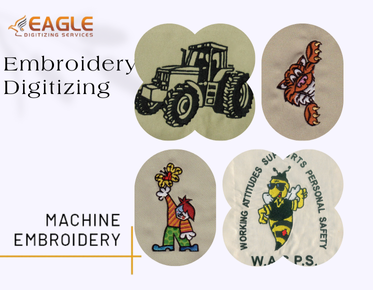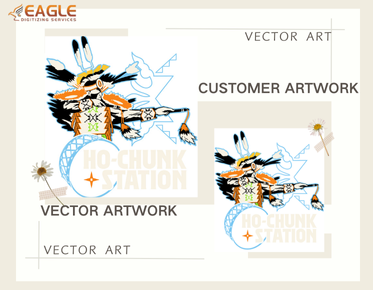Digitized Embroidery with Sequins and Beads: Does It Really Work?
The blend of digitized embroidery with sequins and beads represents a thrilling fusion of technology and tradition. This innovative combination is sparking excitement in the crafting community, as it melds the precision of digital design with the tactile allure of embellishments. In this exploration, we will delve into how digitization enhances the art of embroidery with sequins and beads, uncovering the potential and challenges of this dynamic duo. For the top-notch embroidery digitizing service, don't hesitate to get in touch with us.
Incorporating Sequins and Beads into Digitized Designs
Why Add Sequins and Beads? Benefits and Aesthetic Appeal
Sequins and beads introduce a touch of glamour and texture that elevates any embroidery project. They add visual interest and a tactile quality that makes the finished piece stand out. The reflective surfaces of sequins and the variety of bead materials offer endless possibilities for creating unique, eye-catching designs that are both luxurious and engaging.
The Challenges of Integrating Embellishments in Digital Designs
Integrating sequins and beads into digitized embroidery presents specific challenges. The placement and stitching of these embellishments need to be meticulously planned to avoid interference with the overall design. Additionally, ensuring that the machine handles these elements properly without causing jams or misalignment requires careful calibration and testing.
How Digitizing Affects the Placement and Stitching of Sequins and Beads
When digitizing designs with sequins and beads, the software must account for the additional bulk and weight of these elements. This involves programming precise stitch paths and ensuring that the machine settings are adjusted to accommodate the unique requirements of embellishments. Properly digitized designs will result in seamless integration, with sequins and beads enhancing rather than disrupting the embroidery.
Choosing the Right Sequins and Beads for Digital Embroidery
Types of Sequins: Glossy, Matte, Iridescent, and More
Sequins come in various finishes, each offering different aesthetic effects:
● Glossy Sequins: These reflect light with a shiny, mirror-like surface, perfect for bold and vibrant designs.
● Matte Sequins: Offering a more subdued shine, matte sequins provide a sophisticated, understated look.
● Iridescent Sequins: These change color depending on the angle of light, adding a dynamic, shifting element to the design.
Different Bead Varieties: Glass, Plastic, and Metal
Beads also vary in material and finish:
● Glass Beads: Known for their clarity and brilliance, glass beads are ideal for high-end, detailed designs.
● Plastic Beads: Lightweight and versatile, plastic beads are often used in more casual or cost-effective projects.
● Metal Beads: Offering durability and a sleek appearance, metal beads are suitable for modern, edgy designs.
Matching Sequins and Beads to Your Fabric and Design
Selecting the right sequins and beads involves considering the fabric type and design. Heavier fabrics like denim or canvas can handle larger or more numerous embellishments, while lighter fabrics such as chiffon may require smaller, more delicate beads and sequins. The combination should enhance the fabric and design without overwhelming or distorting them.
Software and Tools for Digitizing with Sequins and Beads
Essential Software for Creating Embellished Designs
Several software programs are tailored for creating digitized embroidery designs with sequins and beads. Look for software that supports multi-layered designs, precise stitch placement, and the ability to simulate the final product. Features like real-time preview and editing tools can greatly enhance the design process.
Features to Look for in Embroidery Digitizing Software
When choosing embroidery digitizing software, consider:
● Customization Options: Ability to create and modify designs to incorporate sequins and beads.
● Simulation Capabilities: Previewing how sequins and beads will appear on the final product.
● User-Friendly Interface: Tools and features should be accessible and easy to navigate for efficient design creation.
Tools and Accessories That Simplify Sequins and Beads Integration
Specialized tools and accessories can make integrating sequins and beads easier:
● Bead Guides and Attachments: Help position and secure beads during stitching.
● Sequins Feeders: Facilitate the automatic placement of sequins, reducing manual handling.
● Extra Needles and Presser Feet: Designed to handle the added bulk and ensure smooth stitching.
Preparing Your Design for Digitized Sequins and Beads
Designing with Sequins and Beads in Mind: Key Considerations
When designing for digitized embroidery with sequins and beads, consider the scale and placement of these elements. Ensure that the design accounts for the additional space required by sequins and beads and that their placement enhances rather than detracts from the overall pattern. Consider how the embellishments will interact with the stitches and fabric.
Setting Up Your File: How to Handle Complex Embellishments
Prepare your design file by clearly defining the areas where sequins and beads will be placed. Use the software to set precise parameters for each embellishment, including stitch types and densities. Ensure that the file is compatible with your embroidery machine and that all elements are correctly programmed.
Preparing Your Fabric for the Digital Embroidery Process
Before digitizing, prepare your fabric by washing, ironing, and stabilizing it. Choose a stabilizer that matches the fabric type to support the stitching and embellishments. Proper preparation ensures a smooth embroidery process and helps achieve the best results.
The Digitizing Process: Step-by-Step
Creating Your Digital Design: From Sketch to Software
Begin by creating a detailed sketch of your design. Transfer this sketch into your digitizing software, where you can refine and adjust the pattern. Add layers for sequins and beads, specifying their placement and stitching requirements. Review and finalize the design before proceeding to the next stage.
Adding Sequins and Beads: How to Program Your Design
Incorporate sequins and beads into your digital design by specifying their locations and stitch types. Use the software to program the sequence of operations for the machine, ensuring that sequins and beads are placed correctly. Test the design with a simulation to verify accuracy.
Previewing and Testing: Ensuring Accuracy Before Production
Before starting production, preview the design to ensure that sequins and beads are accurately represented. Conduct a test run on a sample fabric to check for any issues with placement, stitching, or machine handling. Make necessary adjustments based on the test results to ensure the final product meets your expectations.
Machine Settings and Adjustments
Configuring Your Embroidery Machine for Sequins and Beads
Set up your embroidery machine to handle sequins and beads by adjusting the needle type and thread tension. Ensure that the machine is equipped with the appropriate attachments or accessories for embellishments. Follow the manufacturer's guidelines for configuring settings to optimize performance.
Adjusting Tension and Speed for Optimal Results
Fine-tune the machine's tension and speed settings to accommodate the added bulk of sequins and beads. Test different settings to find the optimal balance for your specific design and fabric. Proper adjustments will prevent issues such as thread breakage or misalignment during stitching.
Troubleshooting Common Issues with Digitized Embellishments
Common issues with digitized embellishments include misaligned sequins, thread jams, and uneven stitching. Address these problems by checking machine settings, cleaning the bobbin area, and ensuring proper needle alignment. Regular maintenance and calibration will help prevent these issues and ensure smooth operation.
Quality Control and Finishing Touches
Inspecting Your Finished Embroidery: What to Look For
After completing the embroidery, inspect the finished piece for any flaws or imperfections. Check for properly secured sequins and beads, consistent stitching, and any areas where the embellishments might be out of place. Ensure that the overall design meets the desired quality standards.
Making Adjustments and Fixes: Ensuring Every Detail is Perfect
Address any issues found during the inspection by making necessary adjustments or fixes. This may involve re-stitching areas, securing loose sequins or beads, or correcting design flaws. Take care to maintain the integrity of the design while addressing any imperfections.
Tips for Properly Securing Sequins and Beads on Fabric
To secure sequins and beads properly, use a strong thread and ensure that each embellishment is firmly stitched. Consider applying a small amount of fabric glue or adhesive to the back of the sequins for added stability. Regularly check for any loose elements and make adjustments as needed.
Care and Maintenance of Digitized Embroidered Items
Cleaning and Washing Sequined and Beaded Embroidery
Clean sequined and beaded embroidery with care to avoid damaging the embellishments. Hand wash gently in cold water with a mild detergent, and avoid wringing or twisting. Lay the item flat to dry, and consider using a mesh bag to protect the embellishments during washing.
How to Store Embellished Pieces to Prevent Damage
Store embellished items in a cool, dry place away from direct sunlight and moisture. Use acid-free tissue paper or fabric to wrap the item, and avoid stacking heavy objects on top. Proper storage will help prevent damage and preserve the appearance of sequins and beads.
Repairing and Replacing Sequins and Beads
Repair worn or detached sequins and beads by carefully reattaching them with the appropriate thread and stitches. Inspect the fabric for any damage and address any issues promptly. Regular maintenance and timely repairs will extend the life of your embroidered items.
Creative Applications for Digitized Sequins and Beads
Fashion Forward: Using Sequins and Beads in Apparel Design
Sequins and beads can elevate fashion designs by adding sparkle and texture to garments. Use them to enhance details such as collars, cuffs, or hemlines, creating striking and unique pieces. Experiment with different placement and patterns to achieve diverse effects.
Home Décor: Adding Sparkle to Cushions, Curtains, and More
Embellish home décor items like cushions, curtains, and tablecloths with sequins and beads to add a touch of luxury and personalization. Integrate the embellishments in patterns or accents that complement the overall décor style. Use a consistent color scheme and design to create cohesive and stylish home accents.
Personalized Gifts: Unique Embellished Creations for Special Occasions
Create personalized gifts by incorporating sequins and beads into custom designs. Add a touch of sparkle to items such as tote bags, pillowcases, or scarves to make thoughtful and memorable presents. Tailor the designs to suit the recipient's preferences and the occasion.
Tips and Tricks from the Experts
Insider Advice on Perfecting Digitized Sequined and Beaded Embroidery
Expert advice on digitized embroidery with sequins and beads includes tips on maintaining machine settings, testing designs before full production, and ensuring proper placement of embellishments. Seek out insights from experienced embroiderers to refine your techniques and achieve the best results.
Common Pitfalls to Avoid and Ways to Overcoming Them
Avoid common pitfalls such as improper machine settings, misaligned embellishments, and inadequate design testing. Address these issues by thoroughly preparing your design, calibrating your machine, and conducting test runs. Learning from others' experiences will help you navigate challenges effectively.
Best Practices for Achieving Stunning Results
To achieve stunning results, follow best practices such as meticulous design planning, careful material selection, and precise machine settings. Regularly inspect your work, make necessary adjustments, and strive for consistency. Implementing these practices will enhance the quality and impact of your digitized embroidered designs.
Digitized embroidery with sequins and beads merges traditional artistry with cutting-edge technology, offering exciting possibilities for creative expression. By understanding the techniques, tools, and considerations involved, you can effectively integrate these embellishments into your designs. Embrace the fusion of technology and tradition, experiment with innovative approaches, and let your creativity shine through in every embroidered piece.



